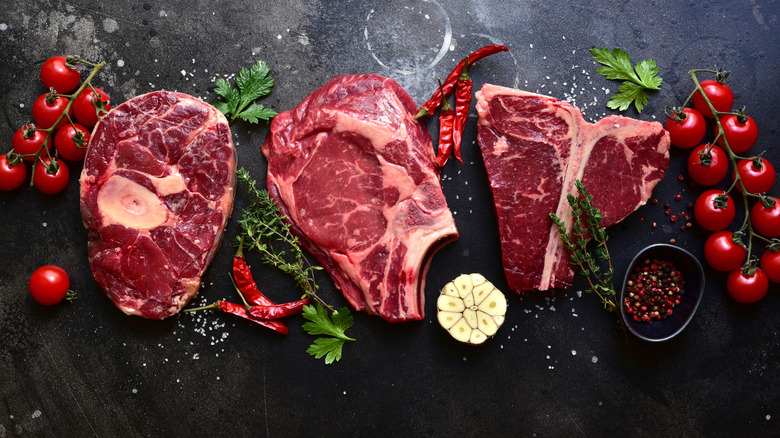LongHorn Steakhouse's Top-Selling Steak Is Known For Its Marbling
Steak lovers will all tell you there's a right way to cook a steak — though ask them what the 'perfect' temp is, or even what counts as medium-well, and the arguments will ensue. Surprisingly, and against all odds, they have set aside their differences with a specific fresh steak from LongHorn Steakhouse as supreme: the coveted ribeye.
Granted, it's not the kind of steak that comes loaded with all the fancy extras like a filet mignon, but it sticks out because of its simplicity, relying only on one impactful quality — marbling. LongHorn even highlights it in its description, calling the 12-ounce ribeye "well-marbled, juicy, and seasoned by our Grill Masters for the best flavor in every bite." Just in case you don't know, marbling is the web of thin white streaks of fat you see running through the steak. Leaner cuts like sirloin or filet might look tidy and uniform, but a ribeye is celebrated for those flecks of fat; they're flavor and moisture waiting to happen.
As the steak cooks, the fat slowly melts and seeps into the meat, keeping it tender and juicy. That's why even when you grill it hot, the ribeye doesn't dry out the way leaner cuts sometimes do. The marbling turns every bite into a mix of beefy richness and melt-in-your-mouth texture, and that's exactly what keeps customers coming back.
Why marbling and technique make the ribeye stand out
The ribeye comes from the upper rib section of the steer, a part of the animal that doesn't get much exercise. Less muscle movement means more tenderness, so when you pair that with abundant marbling, you end up with a steak that doesn't disappoint. LongHorn seizes that natural advantage with careful seasoning and expert grilling. High heat creates a crusty sear on the outside, while the marbled fat inside continues to baste the meat as it cooks. That balance (crisp exterior, juicy interior) is one of the reasons ribeye consistently outranks other cuts in popularity.
Another factor is forgiveness; to be honest, a ribeye steak is hard to ruin. With a filet or a strip, cooking beyond medium can leave you with dryness or muted flavor, and you'll essentially feel like you're chewing on leather. The ribeye is similar to a sirloin when you cook it; the marbling gives you wiggle room. Even if it cooks a little longer, the fat ensures the meat still tastes rich and satisfying. For diners, it offers fewer disappointing bites and more consistency plate after plate.
It also comes down to value because even if the ribeye isn't the cheapest option, it delivers a big flavor payoff that feels worth the splurge. But as far as other steakhouses go, it's relatively affordable. Customers know they're getting a steak that's tender, juicy, and full of character, which is something leaner cuts can't always guarantee. That's why ribeye remains LongHorn's top-seller — it's a reliable favorite with flavor that lives up to its reputation.


